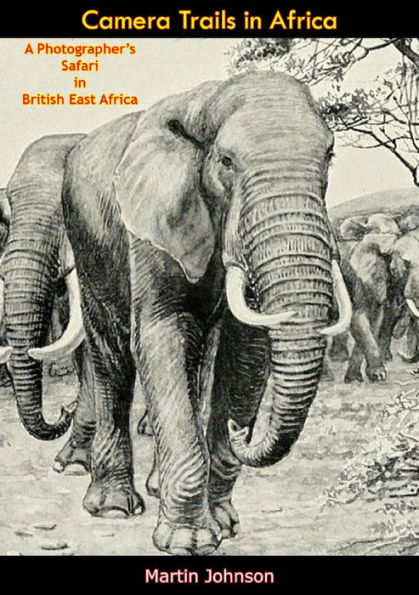Camera Trails in Africa: A Photographer's Safari in British East Africa
Martin and Osa Johnson went to British East Africa in the 1920’s in order to photograph wild animals, many of which were disappearing with the advances of civilization. They ended up falling in love with the country, and did not want to return to the United States.
It is easy to imagine why, considering the Johnsons spent their days wandering around the bush, camping and trekking and photographing. Each morning they ventured out with their cameras to stalk snorting rhinos or magnificent lions against the backdrop of the golden-brown plains and turquoise skies.
But don’t imagine that Johnson’s life as a photographer was always peaceful. At one point, he describes cranking up the motion picture camera as a lion prepares to spring. Later on, Osa saves Martin’s life from a herd of stampeding elephants—all for the sake of the perfect picture.
Although most of the area they covered was uninhabited by people, they did have many African servants who accompanied them on their travels, and they encountered Masai and other tribes along the way.
Martin Johnson was once a member of Jack London’s boat crew, and may have picked up some skills from that famous author. Camera Trails in Africa is a beautifully-written book, and makes you want to “safari off to some country that is still God’s country.
"1004733905"
It is easy to imagine why, considering the Johnsons spent their days wandering around the bush, camping and trekking and photographing. Each morning they ventured out with their cameras to stalk snorting rhinos or magnificent lions against the backdrop of the golden-brown plains and turquoise skies.
But don’t imagine that Johnson’s life as a photographer was always peaceful. At one point, he describes cranking up the motion picture camera as a lion prepares to spring. Later on, Osa saves Martin’s life from a herd of stampeding elephants—all for the sake of the perfect picture.
Although most of the area they covered was uninhabited by people, they did have many African servants who accompanied them on their travels, and they encountered Masai and other tribes along the way.
Martin Johnson was once a member of Jack London’s boat crew, and may have picked up some skills from that famous author. Camera Trails in Africa is a beautifully-written book, and makes you want to “safari off to some country that is still God’s country.
Camera Trails in Africa: A Photographer's Safari in British East Africa
Martin and Osa Johnson went to British East Africa in the 1920’s in order to photograph wild animals, many of which were disappearing with the advances of civilization. They ended up falling in love with the country, and did not want to return to the United States.
It is easy to imagine why, considering the Johnsons spent their days wandering around the bush, camping and trekking and photographing. Each morning they ventured out with their cameras to stalk snorting rhinos or magnificent lions against the backdrop of the golden-brown plains and turquoise skies.
But don’t imagine that Johnson’s life as a photographer was always peaceful. At one point, he describes cranking up the motion picture camera as a lion prepares to spring. Later on, Osa saves Martin’s life from a herd of stampeding elephants—all for the sake of the perfect picture.
Although most of the area they covered was uninhabited by people, they did have many African servants who accompanied them on their travels, and they encountered Masai and other tribes along the way.
Martin Johnson was once a member of Jack London’s boat crew, and may have picked up some skills from that famous author. Camera Trails in Africa is a beautifully-written book, and makes you want to “safari off to some country that is still God’s country.
It is easy to imagine why, considering the Johnsons spent their days wandering around the bush, camping and trekking and photographing. Each morning they ventured out with their cameras to stalk snorting rhinos or magnificent lions against the backdrop of the golden-brown plains and turquoise skies.
But don’t imagine that Johnson’s life as a photographer was always peaceful. At one point, he describes cranking up the motion picture camera as a lion prepares to spring. Later on, Osa saves Martin’s life from a herd of stampeding elephants—all for the sake of the perfect picture.
Although most of the area they covered was uninhabited by people, they did have many African servants who accompanied them on their travels, and they encountered Masai and other tribes along the way.
Martin Johnson was once a member of Jack London’s boat crew, and may have picked up some skills from that famous author. Camera Trails in Africa is a beautifully-written book, and makes you want to “safari off to some country that is still God’s country.
2.99
In Stock
5
1

Camera Trails in Africa: A Photographer's Safari in British East Africa
231
Camera Trails in Africa: A Photographer's Safari in British East Africa
231
2.99
In Stock

Product Details
| ISBN-13: | 9781789125498 |
|---|---|
| Publisher: | Muriwai Books |
| Publication date: | 12/05/2018 |
| Sold by: | Barnes & Noble |
| Format: | eBook |
| Pages: | 231 |
| Sales rank: | 227,145 |
| File size: | 1 MB |
About the Author
From the B&N Reads Blog
